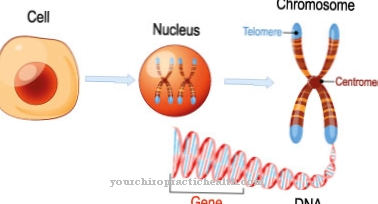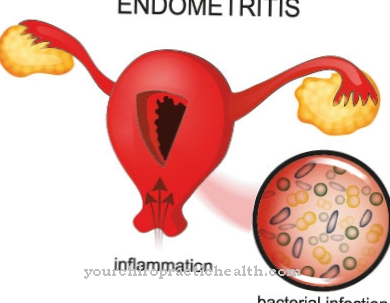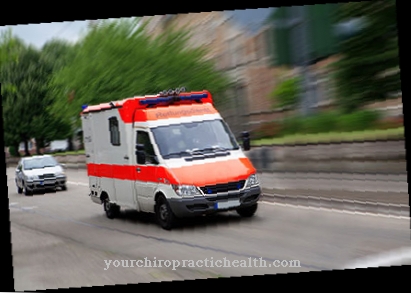In the Rhabdomyolysis the voluntary (striated) muscles dissolve. The causes are diverse, for example an injury to the muscles, autoimmune disease, alcohol or drug abuse.
What is rhabdomyolysis

© PaHa - stock.adobe.com
At a Rhabdomyolysis muscle fibers of the skeletal muscles break down. This means that the muscles begin to break down. This releases large amounts of myoglobin. These reach the kidneys via the bloodstream. This can lead to considerable damage up to and including acute kidney failure. Therefore medical help is absolutely and immediately necessary.
There are different types: traumatic (physical), non-traumatic (non-physical), stress-dependent and stress-independent rhabdomyolysis. Exercise-dependent rhabdomyolysis can result, for example, from too hard training.
causes
Various factors can trigger this disease, for example diseases such as malignant hyperthermia (life-threatening dysfunction of the skeletal muscles), acute toxic myopathy (muscle damage caused by toxins or drugs), autoimmune diseases, metabolic disorders, drugs or ethanol. Ischemias (undersupply of the tissue area with blood) or a lack of oxygen are also triggers.
The most common causes are excessive muscle stretching, muscle compressed air generation, and a crush injury. Bodybuilding circles warn again and again that very hard training, in which the muscles are heavily overloaded, and a simultaneous lack of fluids, can lead to acute muscle inflammation and thus to rhabdomyolysis.
The same applies if the training sessions are too quick one after the other. The toxic causes include cocaine and the contagious triggers include infection. Snakebite poisoning can lead to the dissolution of the voluntary (striated) muscles and thus to rhabdomyolysis. Electrolyte imbalances can also lead to rhabdomyolysis.
Symptoms, ailments & signs
Swollen, soft, and sore muscles are the clearest signs of rhabdomyolysis, while nausea, vomiting, diarrhea, fever, drowsiness, and severe fatigue are non-specific symptoms. The disease can be accompanied by muscle pain, cramps and hardening or swelling of the muscles with a subsequent symptom of paralysis.
At the latest when the urine turns red-brown, a doctor must be consulted immediately, as this is a sign of a very high myoglobin content in the blood and acute kidney failure. Myoglobin is a protein that is responsible for transporting oxygen within the muscles. If the kidneys cannot filter it, the urine will turn color. The symptoms of rhabdomyolysis should not be underestimated as some of them are life-threatening.
Diagnosis & course of disease
Mild rhabdomyolysis is often identified by elevated levels of enzymes normally found in muscle, such as myoglobin, creatine kinase, and lactate dehydrogenase. When myoglobin levels are high, the urine turns reddish-brown due to the excretion of myoglobin by the kidneys. Diagnostics include a detailed medical history, clinical examination, laboratory, electrophysiology, muscle biopsy with pathobiochemistry, muscle MRI, and in some cases electron microscopy.
Complications
Rhabdomyolysis is a complication of various traumatic or non-traumatic processes. Injuries or bruises of muscle tissue, as well as certain poisons (snake poison), infections, drugs, drugs or immunological diseases, can lead to the dissolution of striated muscles. The most dangerous complication of rhabdomyolysis can develop due to the increased excretion of myoglobin by the kidneys.
The myoglobin is formed when muscle tissue is broken down. It often causes the tubules to move in the kidneys, with the iron in the heme damaging the tubular cells. As a result, tubular tissue can die, which often causes acute kidney failure. Furthermore, the so-called compartment syndrome can occur, which is also a serious emergency.
The disturbances in the outflow of venous blood through swellings in the muscle area prevent the inflow of arterial blood, which leads to an undersupply of the muscles and the resulting further necrosis of muscle tissue. At the same time, hyperuricemia often occurs, which is characterized by an increase in the level of uric acid in the blood. From this the symptoms of gout can develop.
In addition, electrolyte disorders such as hyperkalaemia, hyperphosphataemia and hypocalcaemia are not uncommon. These lead to cardiac arrhythmias, heart failure, seizures, tetany, circulatory collapse and psychological impairments such as depression or anxiety disorders. Another complication is the threatening drop in platelet count, which at the same time leads to thrombosis and a strong tendency to bleed.
When should you go to the doctor?
Rhabdomyolysis should always be treated by a doctor. This disease usually does not heal itself and in most cases there is also a significant deterioration in the general condition of the patient. The earlier the disease is recognized and treated, the higher the chance of success.
A doctor should be consulted for rhabdomyolysis if the person concerned suffers from vomiting and nausea. Fever or severe pain in the muscles can also indicate the disease and should be examined by a doctor. In severe cases, the muscles can also be paralyzed, so that the person affected suffers from movement restrictions and can no longer move without any problems. If rhabdomyolysis is not treated, in the worst case it can lead to renal insufficiency, which can be fatal. Rhabdomyolysis can be diagnosed by a general practitioner. However, it has to be treated by different specialists.
Treatment & Therapy
Rhabdomyolysis usually develops over a longer period of time and can sometimes be reversed if the trigger is stopped in good time. The breakdown of the musculature cannot be stopped from a therapeutic point of view, but it recedes by itself after a while. A slight rhabdomyolysis that is recognized in good time can be treated with a strong intake of fluids and, if necessary, additional electrolytes.
Only possible damage to the kidneys and a lack of volume, as the damaged muscle binds fluid, must be countered in good time. With forced diuresis, damage to the kidneys can be avoided. The affected person is given several liters of fluid (physiological saline solution) through infusions in order to accelerate the excretion of the myoglobin and to dilute the myoglobin that has accumulated in the urine.
If this is not sufficient, certain substances also lower the pH value so that the myoglobin dissolves. In extreme cases, dialysis can remove the myoglobin from the blood. The kidneys are cleaned in order to be able to function independently again. The affected muscles must not be strained until all abnormalities have subsided. The most important goal of treatment is to avoid acute kidney injury. If left untreated, rhabdomyolysis ends in fatal kidney failure in most cases. This results from the flooding of the decay products.
You can find your medication here
➔ Medicines for muscle painprevention
To prevent rhabdomyolysis, it is generally necessary to avoid subjecting the muscles to excessive stress, for example through overtraining. In addition, it is essential to ensure that the body does not become dehydrated before, during and after sports activities by drinking enough. Beginners should start slowly and gradually increase their training. Warming up the muscles is important.
If you are ill, you should refrain from exercising and consult a doctor if you are taking medication. Exercising in connection with alcohol or drugs is also strongly discouraged. Sufficient sleep and a healthy and balanced diet with many vitamins and minerals are also very important. Furthermore, you should not train in extreme temperatures, regardless of whether it is cold or hot.
The strain is too great for the entire organism in intense heat or high temperatures below zero. Due to the extreme circumstances, the body cannot process training stimuli accordingly. This can lead to incorrect reactions in the body, for example the breakdown of the striated muscles.
Aftercare
After treatment for rhabdomyolysis, follow-up care is recommended for patients based on the previous therapy. If the muscle decomposition was triggered, for example, by an infection, then during follow-up examinations it is checked whether the pathogens could be eliminated from the patient's body. If an accident or trauma was responsible for the damage to the muscles, the healing process of the tissue is primarily checked during the follow-up examinations.
If the kidneys have been affected by the disease and are no longer working properly, they must regularly take medication that helps kidney function and increases urine production. Regardless of the therapy, patients after rhabdomyolysis receive a nutrition plan and should strengthen their muscles through regular exercises.
A balanced diet is said to help support the body's natural healing abilities and to strengthen the immune system. The lost muscles are rebuilt and strengthened with the help of light sporting exercises. It is particularly important in the early stages that the patients do not overwhelm themselves. Otherwise, the muscles may be damaged again. There is a risk of rhabdomyolysis again. For this reason, care in rehabilitation therapy or adapted physiotherapy is recommended for the patient.
You can do that yourself
Once the diagnosis is made, the treating doctors will try to eliminate the underlying cause of the rhabdomyolysis so that the disease does not get worse. Furthermore, they will treat the disease according to its symptoms and, above all, try to prevent acute kidney failure.
Since the tissue damage that has arisen can only be eliminated through the body's own repair measures, it makes sense for the patient to strengthen their immune system as much as possible. Depending on what condition you are in, you should exercise a lot in the open air. A healthy, stress-free lifestyle also supports the immune system. Patients should therefore not smoke, drink little alcohol and eat healthily. A healthy diet includes many vitamins and minerals from fresh fruits and vegetables, whole grains, and lean meat. Red meat, fatty sausage and sugar should be avoided. Lots of rest, adequate sleep and plenty of drinking - especially water - are very important measures to support the immune system.
Because many immune cells have been found in the intestine, the administration of probiotics is also recommended. It is a preparation with living microorganisms. They should multiply in the intestine and support the immune system there. Doctors with the additional designation "Naturopathy" as well as alternative practitioners can make appropriate recommendations here.





.jpg)
.jpg)





.jpg)



.jpg)










.jpg)
